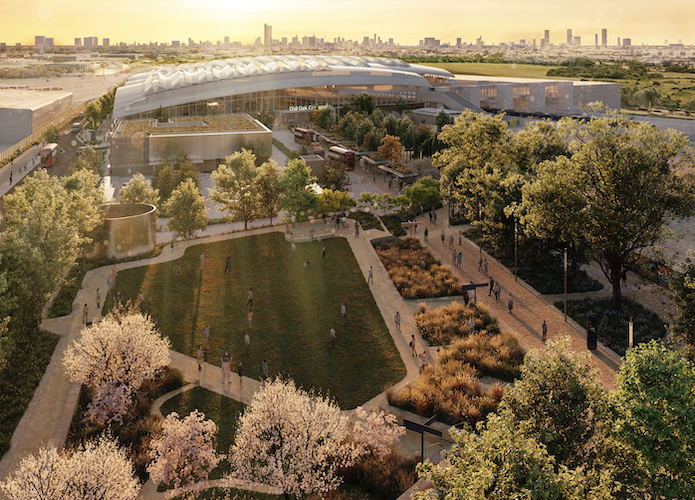A decade on from the London 2012 Olympics there’s been an understandable focus on the record of the London Legacy Development Corporation taking forward the continuing regeneration of the east London site.
But things are moving over in west London too on the extensive, if unloved, lands around the huge HS2 station now under construction. There, plans for 25,500 new homes and 56,500 new jobs are being taken forward by City Hall’s other mayoral development corporation, Old Oak and Park Royal (OPDC).
With wide planning powers but no significant capital budget or land holdings of its own, the corporation hasn’t had an easy ride since it was established by the then Mayor Boris Johnson in 2015.
Less than a year ago OPDC chief executive David Lunts told the London Assembly that the “clock was ticking” on the scheme, with “serious questions” about whether plans for what has been called the largest regeneration site in the UK would actually ever be executed.
The OPDC was set up to piggy-back on the new Old Oak Common station, which has been billed as set to become the best connected ever built in the UK, linking HS2 to Heathrow and to Paddington via an Elizabeth Line station as well as to Wales and the south west of England.
But by the end of 2019 the scheme was faltering. Initial plans had been thrown out by a planning inspector and negotiations with major landowner Cargiant had acrimoniously collapsed, forcing the corporation to return £250 million in government housing infrastructure grants and go back to the drawing board.
Now, Lunts, who took over in 2020 after holding the reins as interim chief executive from March 2019, is sounding more optimistic. For a start, after the much-criticised plans for the Cargiant site were dropped, a new overall blueprint focusing instead on the mainly publicly-owned land closer to the new station got the green light from the inspector and was adopted in June. It has been designated Old Oak West.
“It’s very good news,” says Lunts. “We needed to make significant changes on land use to support what we wanted to do, and getting the local plan approved and adopted was one of the major risks.”
Things are happening on existing development sites in the area too, with the OPDC using its planning powers – which supersede those of the three boroughs with territory in the zone, Ealing, Brent and Hammersmith & Fulham – to get 6,000 new homes underway, with some 7,000 more in the pipeline.
Most significantly, a deal with the government to get the publicly-owned land – 70 acres of it, of which most is owned by the Department for Transport – into play looks a lot nearer than it did a year ago.
A bid to Whitehall, effectively to it all under the control of a single agency – with the OPDC itself well-placed to take on that role – plus vital funding for the significant infrastructure and further land purchases needed to get development underway, won “in principle” approval in April.
Lunts’s team is now working on the next stage. A detailed business case is scheduled for submission in the spring or early summer next year, buoyed by a new sign of City Hall confidence in the plans – a £50 million loan from the Mayor’s land fund to kick-start some 9,000 of the new homes envisaged on the site.
Negotiating with government hasn’t always been easy, with ministers coming and going, and big decisions put on hold during the Conservative leadership campaign. But engagement with senior officials has remained positive, Lunts said. “Although we haven’t got a detailed deal nailed down yet, we are pretty much where we want to be.”
Nevertheless, Lunts adds that much remains to be resolved, including whether the government will want to sell in its land “on day one” or take a longer-term position, which might significantly reduce the initial need for funding. Accountability arrangements will also need to be made for what might still be large amounts of public money.
The announcement last week by the government of plans for new “investment zones” is a further new element in the mix, with City Hall listed as one of the 38 authorities apparently “keen to be involved” and speculation about potential sites beginning.
Government guidance suggests areas aligning “with other significant investments such as HS2 rail stations, to ensure critical mass and greater growth opportunities” will be looked on favourably when applications are made. That would make Old Oak Common, the largest and best connected HS2 site, a prime contender and perhaps a stronger one than other HS2 sites and regeneration areas in London such as Thamesmead, another mayoral priority, where expensive investment extending the Docklands Light Railway is required.
But Lunts says more detail is needed about planning rules, incentives and the affordable housing requirements which are central to mayoral policies. All of these would be in the balance as local politicians decide whether to apply, as well as what funding might be available.
Whatever institutional framework emerges, Old Oak, perhaps the biggest inward investment or housing opportunity in London not already under development – and with its transport connections already assured – represents an increasingly good bet for Whitehall, according to Lunts.
“If government wants to secure a major economic growth opportunity in the capital it needs look no further than Old Oak,” he says. “It speaks directly to the growth, growth, growth agenda.”
Initial public engagement about plans for Old Oak West will get underway this month, with drop-ins and an online session between 12 and 15 October ahead of more detail in a supplementary planning document next year.
Image: Artist’s impression of HS2 station and surroundings from HS2 website.
On London strives to provide more of the kind of journalism the capital city needs. Become a supporter for just £5 a month. You will even get things for your money. Details here.
